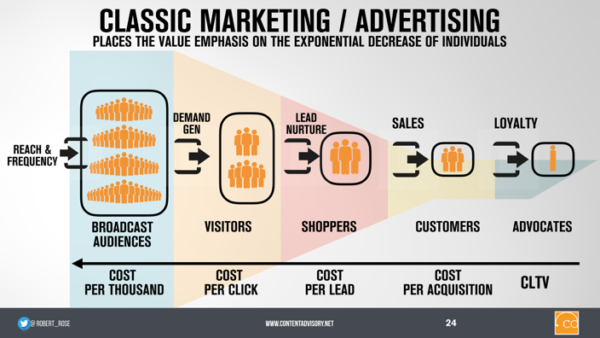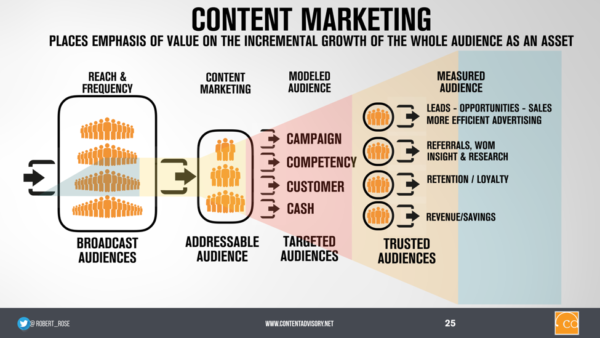Ready for a new job? No, I don’t mean that. Unless of course I do – but then that’s a different conversation for different beverages. I mean are you ready for a new role in addition to the one you have now?
Our content marketing research this year illustrates that one of the key differentiators of those who are succeeding with content as a strategic function of their marketing is the focus on building audiences. Some 90% of those who consider their content marketing “successful” cite building an audience as their main focus. This is a notable jump from the previous year’s 60%.
What these businesses are discovering is that looking at content only as a campaign or as a replacement for other marketing assets is a flawed approach. When content is only seen as a means of feeding direct marketing campaigns, there is only one directly attributable value – a replacement for the advertisement, brochure, or other creative marketing asset. And, guess what? Content often is more expensive than those other options. It’s harder. And, it takes longer. So, it’s frustrating.
The successful businesses have discovered that content marketing must provide more than one type of value to be worth the investment. It must provide integrated value across multiple areas in the business.
#Contentmarketing must provide more than one type of value to be worth the investment, says @Robert_Rose.
Click To Tweet
Re-examining the funnel
This evolution of content marketing is best expressed when I illustrate the differences between looking at a funnel-based marketing approach vs. an audience-building approach.
In classic marketing (see the image below), you start by finding the largest audience you can and placing content (sometimes called brochures or advertising) in front of that audience. You transform a portion of the audience into visitors. Then, through compelling, persuasive content, you evolve a smaller number of those into leads. This process continues until you convince a few to become customers. From there, you hope a percentage will evolve into loyal brand evangelists.
There are two keys to this model. First, it’s built on the premise that each step advances an ever-decreasing number of people to the next step. Hence the name “funnel.”
But, more importantly, it devalues (sometimes to the point of negligence) anyone who falls out at each step. Anyone who falls out of the funnel is simply, well, gone. You start back at scratch to pull them in again.
The second key is that you associate the value of cost savings with the acquisition of the group in the previous step. Across the spectrum, you measure:
- Lifetime value of customer – measured against …
- Cost per customer acquisition – leading back to …
- Cost per qualified opportunity – which is informed by …
- Cost per lead – which is measured out of …
- Cost per visitor – which is compared to …
- Cost per thousand (CPM) – for that reach and frequency
Today’s smart marketers memorize these numbers across all of these costs. And, many times these metrics are how budgets and strategies are set. As a side note, with so much measurement built on cost, is it any wonder that so much of marketing strategies is built on the question “how expensive is it?”
Now, to be clear, this model is extraordinarily valuable, has worked well for decades, is not going away, and is in no way broken (well, OK maybe it’s a little broken – but that’s for a different post). The funnel approach is classic direct marketing and advertising.
But this approach isn’t building an audience. And, if you treat content marketing this way – you will ultimately fail.
Rather, when you build an audience (see image below), you still begin from attracting that larger, broadcast audience into your content. But from that point, you look to leverage business value from each and every interaction with ALL of the members of that audience. You ostensibly flip the funnel to increase value by increasing the size of the audience at every step, and using the trust built with each and every subscriber.
Yes, some members of the audience will become customers – traversing the traditional funnel, from lead to opportunity to customer. But, some will provide value by evangelizing your brand and sharing your message with hard-to-reach-consumers who themselves will become customers. Some will provide business value by helping decrease your media costs by providing data that helps you direct advertising through more relevant channels. Some audience members will provide business value by delivering insight into where, who, what, and how you should be selling what you sell.
I’ve written before about the multiple lines of business value that an audience can generate. But as this new idea starts to get legs, I’m noticing a new role (or set of skills) becoming critically important to the content marketing team.
Enter the audience strategist
At Content Marketing World this year, I introduced an audience valuation framework for measuring success with these strategic content initiatives at any point in the customer’s journey. I really do see the ability to forecast, strategize, assemble, manage, and scale the audience-as-corporate-asset as one of the most important new frontiers for content practitioners.
We have spent the last two decades focusing on how to structure, flow, adapt, and optimize the usability of content in digital interfaces. And while this skill is more needed than ever, the most valuable asset that marketers manage lies beyond the content.
It’s the subscribed audience itself. Someone needs to manage it.
The most valuable asset that marketers manage is the subscribed audience. Someone needs to manage it.…
Click To Tweet
Content marketers are perfectly suited for this job. Managing the asset called an audience has much in common with managing the asset called content. It’s a wonderful balance between marketing, technology, and business strategy. When I’ve been working with clients on this – the role that evolves looks at:
- Audience development – building in the content promotion programs that will ultimately acquire and/or retain the most targeted A-level audiences to the company’s content platforms
- Audience segmentation – understanding which programs produce the highest-quality audience members, and segmenting them into natural stratifications of business value
- Audience valuation – auditing audiences to understand what data you have, and what data is needed to enrich the audience asset
- Audience integration – working with disparate parts of the business to understand where and how having insight or access to audiences can help optimize the business strategy
- Audience measurement – managing the audience asset and measuring its value over time as a broader part of a content marketing effort
You can see in many ways that the work for an audience strategist resembles what you’ve been doing with content for so long. Even if you’re just looking through the intelligent content lens, you can see the parallels:
- Strategic approach to developing the audience as a business asset
- Efficient use of people, processes, and technology to make use of the audience asset
- Efforts that help scale the use of the audience asset throughout the business
- Design for automation, personalization, and including components that can be mixed and matched in assembly-line style
- Data-enriched asset appropriately structured for retrieval and reuse
In other words, one important opportunity for tomorrow’s content strategist lies in the role of audience strategist. People who take on this role will have strategies to pursue, technologies to implement, and standards to create and enforce – not with content but with the subscribers who consume it. This leadership role will manage the data-enriched art and architecture of the subscribed audience.
I think it’s maybe the coolest new role in the company. Enter – the audience strategist.
Want to gather with other people who want or have cool roles strategizing for content (and audiences) in their company? Register today for Intelligent Content Conference March 20-22 in Las Vegas.
Cover image by Joseph Kalinowski/Content Marketing Institute
The post Audience Strategist: The New, Critical Role on Your Content Team appeared first on Content Marketing Institute.



No comments:
Post a Comment